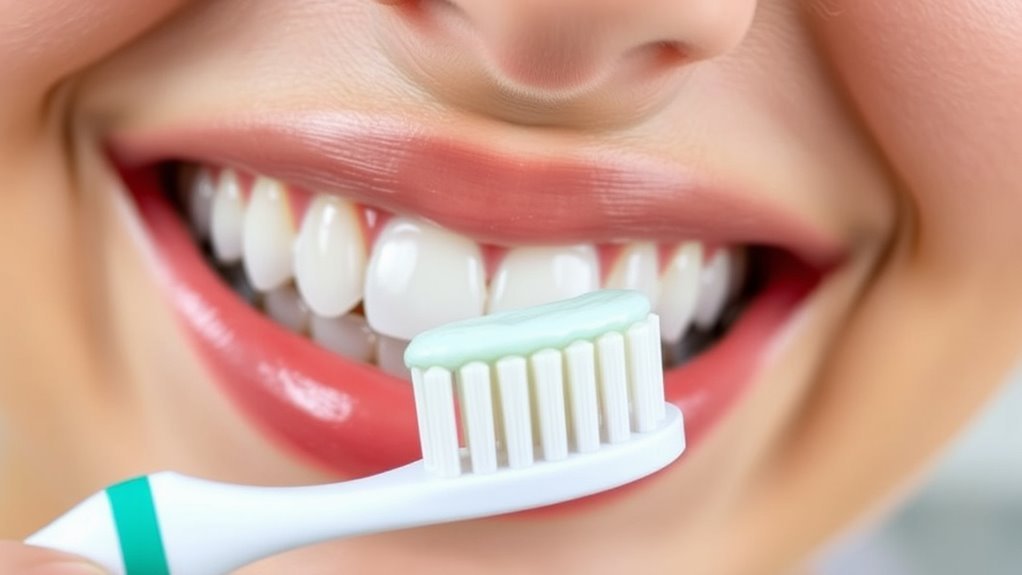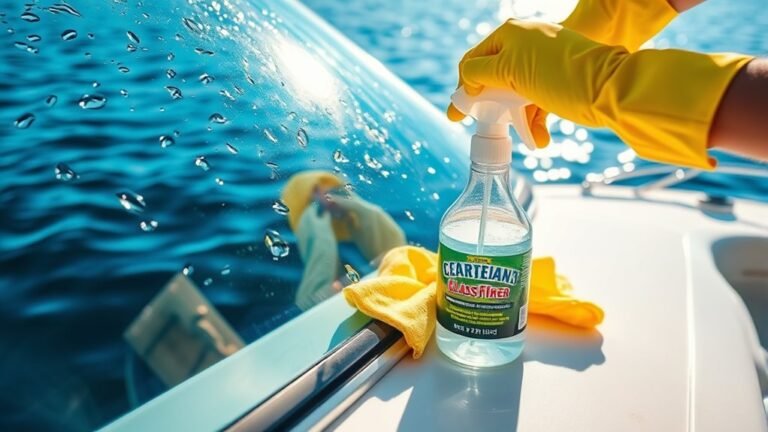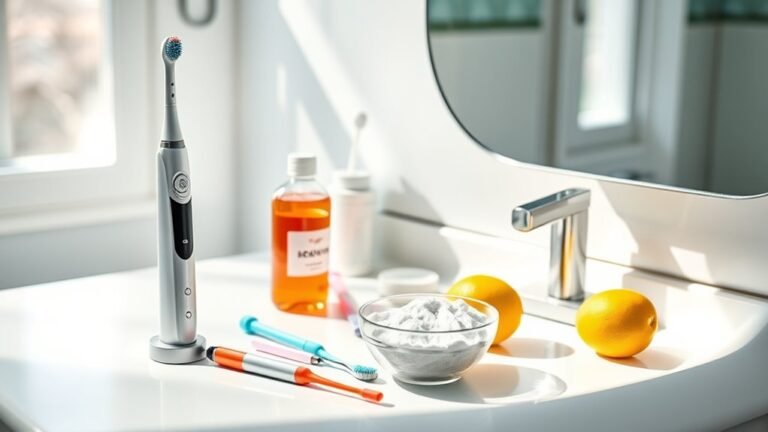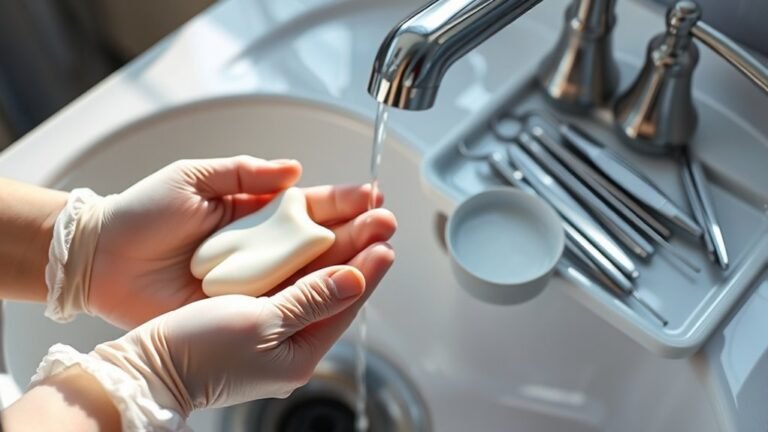How to Clean Teeth With a Permanent Retainer
To clean teeth with a permanent retainer, gather tools like interdental brushes, soft-bristle toothbrush, and dental floss. Start by wetting your toothbrush and applying fluoride toothpaste, then brush at a 45-degree angle to the gum line. Carefully clean around the retainer to remove plaque and food particles, using floss threaders for hard-to-reach areas. Rinse with an antimicrobial mouthwash to combat bacteria. Proper techniques can guarantee long-term cleanliness, and there’s more to explore about maintaining your retainer.
##
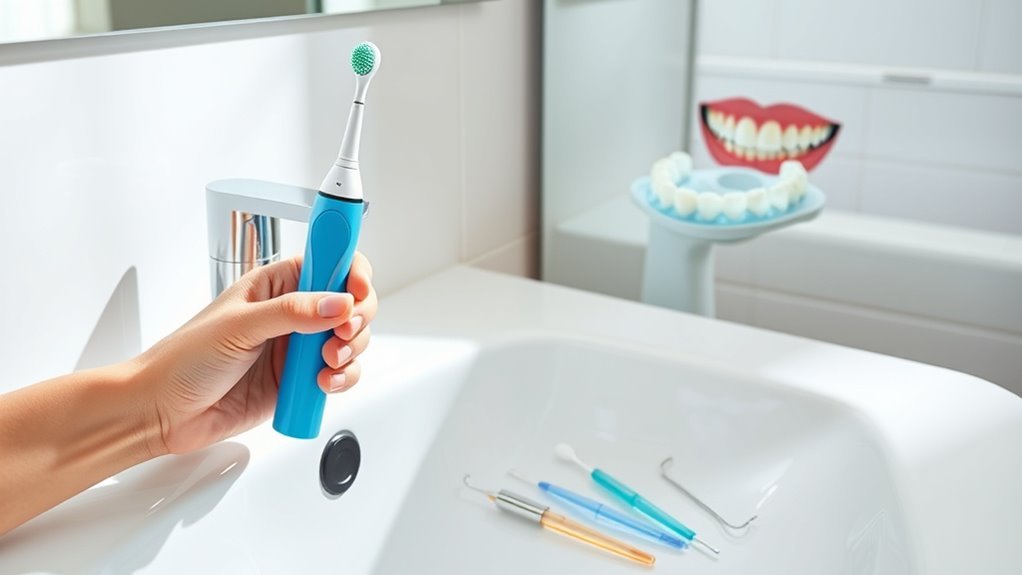
Maintaining oral hygiene with a permanent retainer can be a bit tricky, but it’s crucial for your overall dental health. In this article, we will provide you with effective tips and techniques to keep your teeth clean and your smile radiant despite the challenges posed by a retainer. You’ll learn about the best tools to use, such as soft-bristled toothbrushes and floss threaders, as well as the importance of incorporating mouthwash into your routine. We’ll also emphasize the significance of regular professional dental cleanings. By following these guidelines, you’ll be well-equipped to prevent gum disease and cavities, ensuring that your smile remains both healthy and beautiful.
Preparation For Cleaning
How can you effectively prepare for cleaning your teeth with a permanent retainer? Securing ideal oral hygiene and retainer care is essential. Start by gathering all necessary items to facilitate a smooth cleaning process.
Effective preparation for cleaning your teeth with a permanent retainer is crucial for maintaining optimal oral hygiene.
- Choose a well-lit area to enhance visibility.
- Make sure you have a mirror nearby for better control and observation.
- Gather your cleaning tools, like interdental brushes or floss threaders.
Tools and Chemical Required
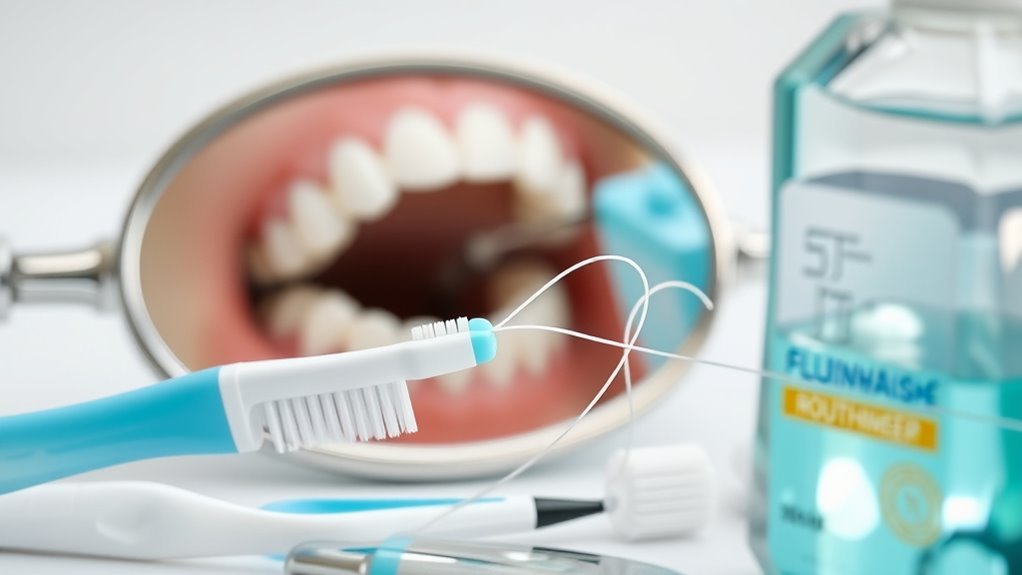
Cleaning teeth with a permanent retainer requires specific tools and chemicals to guarantee effective oral hygiene. To maintain orthodontic hygiene, you’ll need the right cleaning solutions and instruments to reach those hard-to-clean areas around your retainer. Here’s a concise list of essential tools and their functions:
| Tool/Chemical | Purpose |
|---|---|
| Interdental brushes | Clean between teeth and retainer |
| Soft-bristle toothbrush | Gently brush teeth surfaces |
| Dental floss | Remove plaque and food particles |
| Antimicrobial mouthwash | Combat bacteria |
| Orthodontic cleaning solution | Break down stubborn deposits |
Utilizing these tools and chemicals will help you maintain the best oral health while enjoying the benefits of your permanent retainer.
How to Clean:
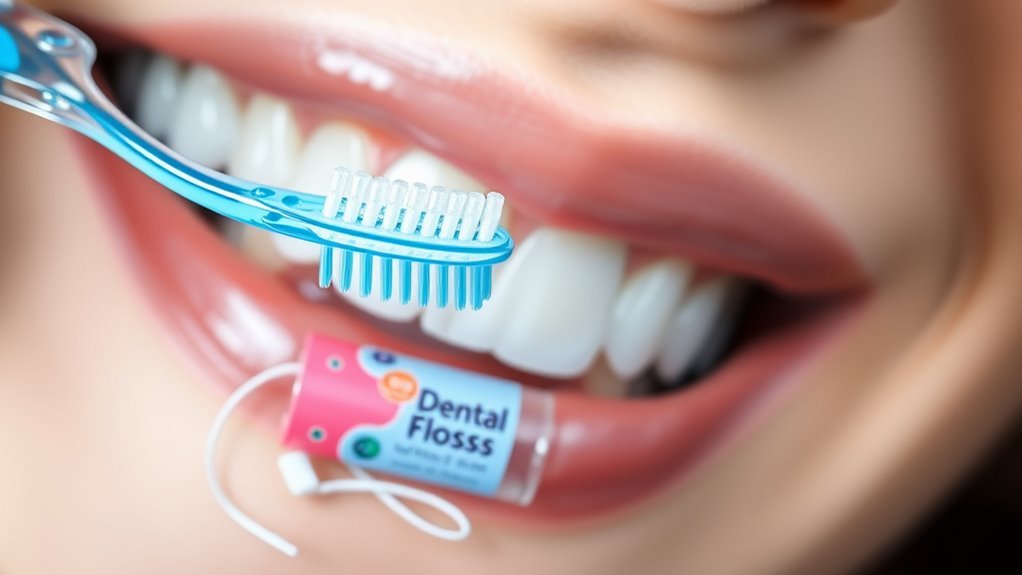
Step 1: Gather Your Cleaning Supplies
- Soft-bristled toothbrush: Choose a toothbrush that is gentle on your gums and effective in cleaning.
- Fluoride toothpaste: Opt for a fluoride toothpaste to help prevent cavities and strengthen your enamel.
- Dental floss: Use either traditional dental floss or orthodontic floss designed for braces and retainers.
- Floss threader (optional): This tool can be helpful for maneuvering floss around the retainer.
- Interdental brushes (optional): These can be used to clean between teeth and around the retainer more effectively.
Step 2: Prepare Your Toothbrush and Toothpaste
- Wet the bristles of your soft-bristled toothbrush under running water.
- Squeeze a pea-sized amount of fluoride toothpaste onto the brush.
- Ensure that the bristles are adequately coated with toothpaste for effective cleaning.
Step 3: Brush Your Teeth
- Hold the toothbrush at a 45-degree angle to your gum line.
- Gently brush the outer surfaces of your teeth in a circular motion, paying special attention to areas around the retainer.
- Move on to the inner surfaces of your teeth, again using circular motions for thorough cleaning.
- For the chewing surfaces, use a back-and-forth motion to remove any remaining plaque or food particles.
Step 4: Clean Around the Retainer
- Carefully brush around the retainer, angling the toothbrush to reach the spaces between the retainer and your teeth.
- Take your time to ensure that all areas around the retainer are thoroughly cleaned to prevent plaque buildup.
Step 5: Floss Your Teeth
- If using a floss threader, thread the floss through the tool and use it to navigate around the retainer.
- Gently slide the floss between your teeth, making sure to wrap it around each tooth before pulling it out. This helps remove plaque and food particles effectively.
- If not using a threader, use orthodontic floss to maneuver around the retainer, following the same gentle technique.
Step 6: Floss Daily
- Make it a habit to floss at least once a day to keep your teeth and gums healthy.
- Consistent flossing will help prevent cavities and gum disease, especially in areas that are hard to reach with a toothbrush.
Step 7: Rinse Your Mouth
- After brushing and flossing, rinse your mouth thoroughly with water or an antibacterial mouthwash.
- This will help wash away any loosened debris and provide additional freshness to your mouth.
Step 8: Regular Dental Check-ups
- Schedule regular visits with your dentist or orthodontist to ensure that your teeth and retainer are in good condition.
- Professional cleanings can help maintain oral health and address any issues that may arise with your retainer.
Safety Consideration
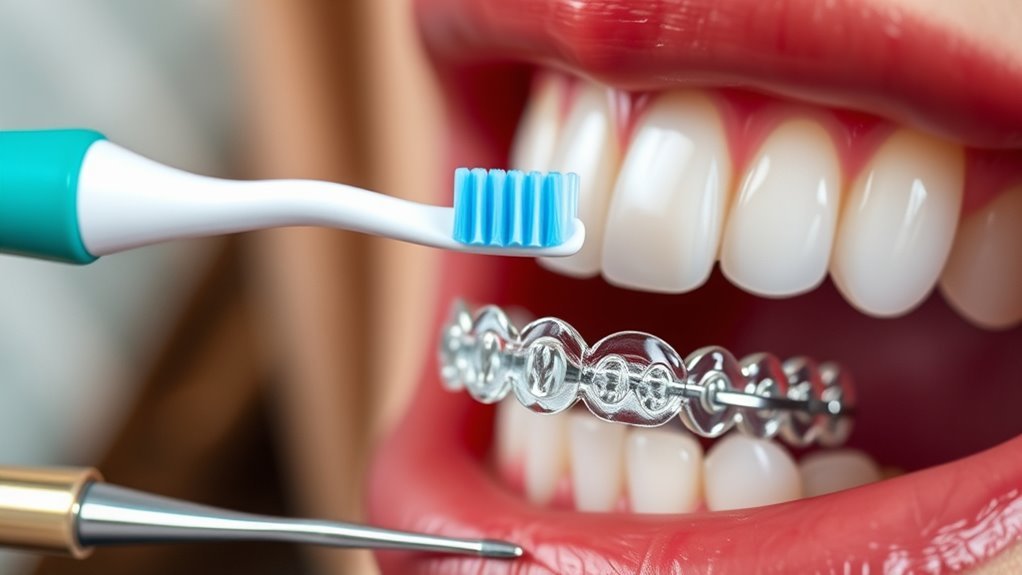
Maintaining good oral hygiene around a permanent retainer is important for your dental health, but it’s equally essential to contemplate safety during the cleaning process. When performing retainer maintenance, use tools designed specifically for this purpose. Avoid sharp instruments that could damage your retainer or scratch your enamel. Opt for soft-bristled toothbrushes and gentle cleaning solutions to prevent irritation to your gums and teeth. Always guarantee that your hands are clean before touching your mouth to reduce the risk of introducing bacteria. Additionally, be cautious with dental floss; threading it improperly can cause damage to the retainer. By prioritizing safety alongside effective oral hygiene, you can maintain a healthy mouth and extend the lifespan of your retainer.
Tips to keep clean for long time
Although it may seem challenging, keeping your permanent retainer clean for the long term is achievable with the right practices. Incorporating effective flossing techniques and choosing appropriate mouthwash options can greatly enhance your oral hygiene routine. Here are some tips to help you maintain cleanliness:
- Use a floss threader or orthodontic floss to navigate around the retainer easily.
- Rinse with an antibacterial mouthwash regularly to reduce plaque buildup.
- Schedule regular dental check-ups to monitor your retainer’s condition and overall oral health.
- Regularly cleaning high-touch surfaces in your home can also help reduce overall germ buildup and support your oral health.
Frequently Asked Questions
Can I Use Regular Toothpaste With a Permanent Retainer?
Yes, you can use regular toothpaste with a permanent retainer, but it’s best to choose a non-abrasive type to avoid damaging the retainer. Toothpaste types that are fluoride-based work well for maintaining dental health. When cleaning, use gentle brushing techniques, focusing on areas around the retainer. Additionally, consider incorporating interdental brushes or floss threaders to guarantee you’re effectively removing plaque and debris that can accumulate around the retainer.
How Often Should I Clean My Teeth With a Retainer?
You should clean your teeth with a retainer at least twice a day, as studies show that 80% of dental issues stem from inadequate oral hygiene. This cleaning frequency is essential for effective retainer maintenance and preventing plaque buildup. Regular brushing and flossing, especially around the retainer, can greatly reduce the risk of cavities and gum disease. Staying consistent with your routine gives you the freedom to enjoy a healthier smile for longer.
Is Flossing Necessary With a Permanent Retainer?
Yes, flossing is necessary with a permanent retainer. You’ll need to adopt specific flossing techniques to maintain your retainer and guarantee your teeth stay healthy. Use a floss threader or orthodontic floss to navigate around the retainer effectively. This helps remove plaque and food particles that can lead to decay and gum disease. Consistent flossing is crucial in your retainer maintenance routine, so don’t skip this step if you want ideal oral health.
Can a Permanent Retainer Cause Bad Breath?
Yes, a permanent retainer can contribute to bad breath if proper oral hygiene isn’t maintained. Food particles and plaque can accumulate around the retainer, leading to bacterial growth that causes unpleasant odors. To prevent this, you should brush your teeth thoroughly, including areas around the retainer, and consider using interdental brushes or floss specifically designed for retainers. Maintaining consistent oral hygiene is essential for keeping your breath fresh and your teeth healthy.
What Should I Do if My Retainer Feels Loose?
If your retainer feels loose, don’t panic; it’s a common issue. First, check for any visible damage or detachment. Regular retainer maintenance is essential, so if you notice any shifts, contact your orthodontist immediately. They can assess whether it needs adjustment or replacement. Ignoring a loose retainer could lead to misalignment, compromising your dental freedom. Stay proactive about your oral health to keep your smile intact and confident!
